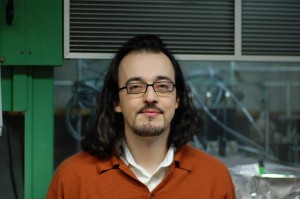 A passion for the fundamental sciences and for things that grow motivate Ludovico Cademartiri, an assistant professor in materials science and engineering, as he develops methods for making new materials using polymers and crystals at Iowa State University.
A passion for the fundamental sciences and for things that grow motivate Ludovico Cademartiri, an assistant professor in materials science and engineering, as he develops methods for making new materials using polymers and crystals at Iowa State University.
In a recent study, Cademartiri led a team of scientists that researched the formation and properties of nanowires, which are strands of solid matter 50 thousand times thinner than the average human hair.
He explains that current research applies nanowires as fillers for composites and electrodes for batteries, electronic circuitry, such as radio transistors, and all applications where both high surface area and connectivity are required. He adds that the nanowires made in his study might find application in light detectors or thermoelectric devices.
However, Cademartiri said nanowires are still being developed for application in commercial products.
A new class of materials
The scientific journal Advanced Materials published a paper on this topic, entitled “Nanowires and Nanostructures that Grow like Polymer Molecules,” that Cademartiri wrote alongside his graduate student Santosh Shaw.
Cademartiri says the paper was designed and developed to help researchers understand how and why nanowires produced in his study form in a way akin to polymers. It also reviews existing research about polymer-like growth and behavior in crystals and nanostructures and proposes guidelines for creating “polymer-like” crystals and assemblies.
“We’re interested in the fundamental question of whether we can get crystals to behave like polymer molecules,” Cademartiri said.
In general, nanowires are made through a process that produces crystals, called crystallization. But the nanowires made in Cademartiri’s study formed in a process similar to polymerization, which makes polymer molecules.
He says this research also demonstrated that scientists could potentially create nanowires that possess polymer-like traits, such as flexibility.
He hopes the publication could also be the start of a dialogue between polymer and crystal scientists.
“We believe there are a lot of perceived differences between the crystals and polymers are often based on old and maybe unwarranted assumptions,” he said regarding polymers and crystals. “If these nanowires are really what they could be, they could serve as a means for scientists from traditionally separate fields to talk to each other in a more productive and creative fashion.
January 7, 2014 by Eric Debner